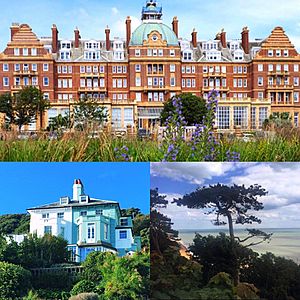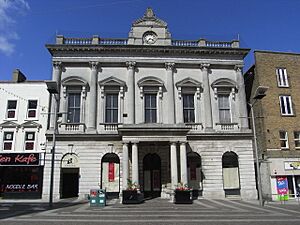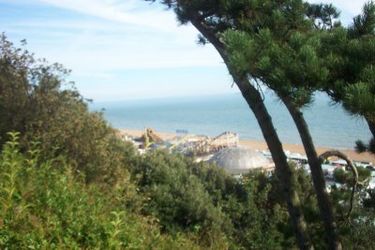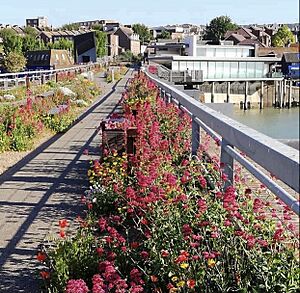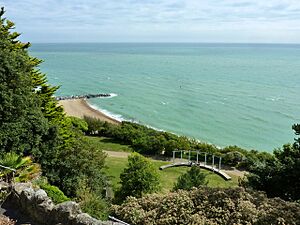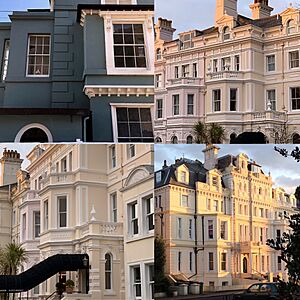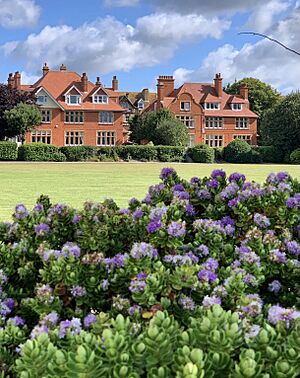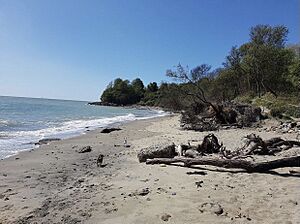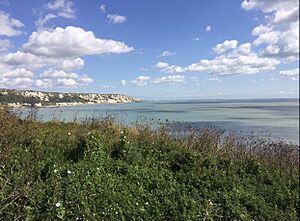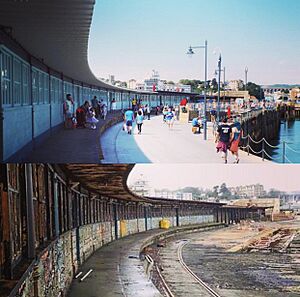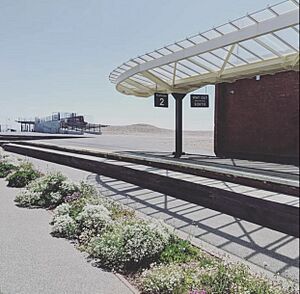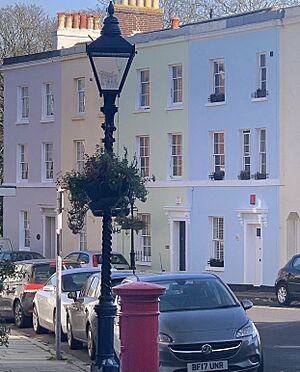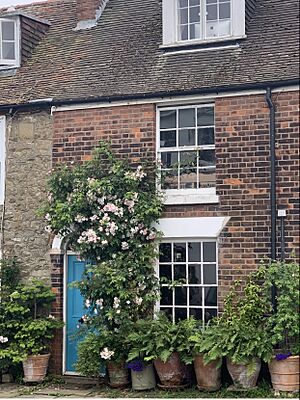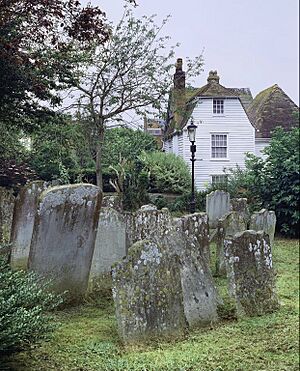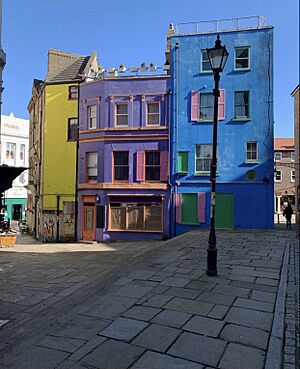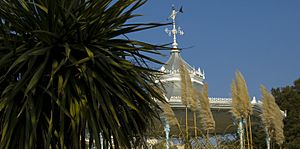Folkestone facts for kids
Quick facts for kids Folkestone |
|
|---|---|
| Port town | |
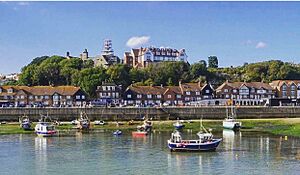 |
|
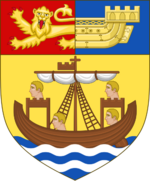 Arms of Folkestone Town Council |
|
| Population | 46,698 (2011) |
| OS grid reference | TR218361 |
| • London | 71.3 mi (114.7 km) |
| District |
|
| Shire county | |
| Region | |
| Country | England |
| Sovereign state | United Kingdom |
| Post town | FOLKESTONE |
| Postcode district | CT18–CT20 |
| Dialling code | 01303 |
| Police | Kent |
| Fire | Kent |
| Ambulance | South East Coast |
| EU Parliament | South East England |
| UK Parliament |
|
Folkestone is a cool coastal town in Kent, south-east England. It sits right on the English Channel, which is the sea between England and France. The town is built on cliffs, with a valley running between them. For a long time, especially in the 1800s, Folkestone was a very important harbour and a popular holiday spot by the sea.
People have lived in this area since the Mesolithic era, which was a very long time ago! In the 600s, a special religious house for women, called a nunnery, was started here by a princess named Eanswith. She is still remembered in the town's history. Folkestone grew into a busy seaport in the 1200s. In the early 1800s, the harbour was made bigger to help protect against a possible French invasion. When the railway arrived in 1843, Folkestone became an even more popular and fancy holiday resort. This was thanks to the Earl of Radnor, who invested a lot in the town's design.
During the Edwardian era (the early 1900s), Folkestone was a super fashionable place. Even royalty, like Queen Victoria and Edward VII, visited! You can still see how grand the town was by looking at its buildings, especially in the West End. There are many impressive houses, villas, and large hotels built for important visitors. After two big world wars and when people started taking holidays abroad more often, the town became less popular. The harbour's trade also slowed down after the Channel Tunnel opened nearby and ferry services stopped. However, the harbour is still used today.
Contents
- What's in a Name? The Story of Folkestone
- Exploring Folkestone's Past
- How Folkestone is Run
- Folkestone's Location and Landscape
- Folkestone's Economy: How People Make a Living
- Cool Places to See in Folkestone
- Getting Around Folkestone
- Learning in Folkestone
- Fun Things to Do in Folkestone
- Folkestone's Culture and Arts
- Local News and Radio
- Sports in Folkestone
- Famous People from Folkestone
- Folkestone's Twin Towns
- See also
What's in a Name? The Story of Folkestone
The name Folkestone has a long history. Even though people from different parts of Europe settled in Kent a long time ago (around 450 AD), the name Folcanstan didn't show up until the late 600s. Most people think it means "Folca's stone." This stone might have been a meeting place for the local area.
The spelling of "Folkestone" wasn't set in stone until the mid-1800s. The Earl of Radnor asked for the town's name to be spelled the same way everywhere. You might still see it misspelled sometimes as Folkston or Folkstone!
Exploring Folkestone's Past
People have lived in the Folkestone area for a very, very long time, even since the Mesolithic era (Middle Stone Age). In 2010, tools made from flint were found under the remains of a Roman villa. Digs on the East Cliff have found items from the Stone Age all the way to the Roman Era.
Life in the Iron Age and Roman Times
On the East Cliff, there was a large Iron Age settlement called an oppidum. People here made many quern-stones, which are stones used to grind grains into flour. They traded these stones for goods from other countries, like pottery and wine. Later, a small Roman-style villa was built over this Iron Age settlement around 100 AD. A fancier one was built around 200 AD. For unknown reasons, the Romans left the villa in the 3rd or 4th century.
The Story of Saint Eanswythe
In 597 AD, Christian monks arrived in Kent to bring Christianity back to Britain. They were welcomed by King Ethelbert and his Christian Queen, Bertha. Later, King Ethelbert's daughter, Eanswythe, decided not to marry. In 630 AD, she started a nunnery (a place where nuns live) near Folkestone. This was close to her father's castle and where the Church of St Mary & St Eanswythe is today.
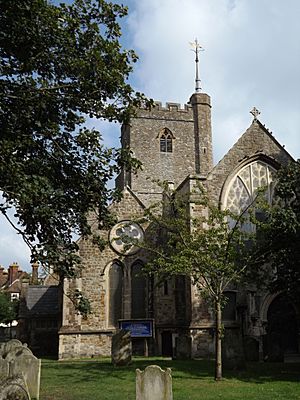
Eanswythe died around 640 AD and quickly became a saint. Her remains were moved to the church in the 1100s. People came to pray and go on pilgrimages there, and Eanswythe became the town's special saint. The nunnery grew into a monastery, but it was later closed by King Henry VIII. St Eanswythe's remains were lost for a while.
They were found again in 1885 by workers changing the church's altar. They found a lead box hidden in a wall. Experts later confirmed the box was from the Anglo-Saxon period and held the bones of a woman in her early 30s. These special items are still in the church today. St Eanswythe is celebrated every year on September 12th. She also appears on the town's seal with William Harvey, a famous doctor from Folkestone who discovered how blood circulates in the body.
Folkestone as a Trading Port
A Norman knight took control of Folkestone, which helped it become part of the Cinque Ports in the 1200s. This meant it was a rich trading port. By the start of the Tudor period, Folkestone was a proper town. Wars with France led to the building of defenses and plans for a Folkestone Harbour.
The harbour was developed in the early 1800s. But the biggest change came with the railway in 1843. Dover Hill, the highest point in Folkestone, was used to help measure the exact distance between the Royal Greenwich Observatory in England and the Paris Observatory in France.
Folkestone Harbour: A Busy Hub
For a long time, Folkestone was a small fishing village. Its seafront was often damaged by storms, making it hard for boats to land. In 1807, a law was passed to build a pier and harbour. Thomas Telford built it in 1809. By 1820, the harbour covered about 14 acres.
Folkestone's trade and population grew, but sand and mud from the Pent Stream still caused problems. The Folkestone Harbour Company tried hard to remove the mud but didn't have much success. In 1842, the company went bankrupt, and the government sold the harbour. The South Eastern Railway Company (SER) bought it. They were building the railway line from London to Dover.
Work began right away to clear the harbour and build a railway line down to it. Folkestone quickly became the SER's main stop for trains going to Boulogne in France. Today, there are plans to rebuild the harbour area. These plans include a new marina, shops, homes, and a performance area.
There is also another idea to keep the old harbour railway and station. This would be a heritage site and a museum about leaving for war. This is because the Folkestone Harbour Branch was very important in both world wars for soldiers going overseas. The old railway station is not used anymore and is slowly being taken over by nature.
How Folkestone is Run
Folkestone is managed by both national and local governments. For the national government, Folkestone is part of the Folkestone and Hythe area. This area is currently represented by Tony Vaughan (Labour) in the UK Parliament.
Local government has three levels. The first level is Kent County Council. Folkestone is split into two areas, each with one County Councillor. The second level is the non-metropolitan district. Folkestone is part of the Folkestone and Hythe district. Folkestone elects 10 of the 30 Councillors for this district.
The third and lowest level is the civil parish. Because Folkestone has a special Town Charter, it has a Folkestone Town Council. This council is based at Folkestone Town Hall. The Town Council has 18 councillors elected from eight different areas within Folkestone. Every year, they choose a Town Mayor and a Deputy Mayor.
|
Folkestone's Location and Landscape
Folkestone is where the southern edge of the North Downs hills meets the sea. Unlike the white cliffs at Dover, Folkestone's cliffs are made of different types of rock and clay. A small stream, Pent Brook, cuts through the cliffs. This stream provided a safe spot for fishermen and cross-channel boats long ago.
The sea constantly wears away at the cliffs. So, people have had to build artificial protections like breakwaters and piers since the 1600s. The town is now built on both sides of the original valley. The Pent Stream now flows through an underground pipe until it reaches the inner harbour. Parts of an old quay from the 1600s were found under a public car park near the harbour.
The town also includes areas like Cheriton, where the northern exit of the Channel Tunnel is located. In August 1996, a very rare storm caused major flooding in the Foord Valley area. Heavy rain and problems with the Pent Stream caused homes and businesses to be under two meters of water.
What's the Weather Like?
| Jan | Feb | Mar | Apr | May | Jun | Jul | Aug | Sep | Oct | Nov | Dec | Year |
|---|---|---|---|---|---|---|---|---|---|---|---|---|
| 8.0 °C (46.4 °F) | 8.0 °C (46.4 °F) | 7.5 °C (45.5 °F) | 9.3 °C (48.7 °F) | 11.6 °C (52.9 °F) | 14.1 °C (57.4 °F) | 16.0 °C (60.8 °F) | 17.6 °C (63.7 °F) | 17.7 °C (63.9 °F) | 16.2 °C (61.2 °F) | 14.2 °C (57.6 °F) | 11.1 °C (52.0 °F) | 12.6 °C (54.7 °F) |
Folkestone's Economy: How People Make a Living
Folkestone used to be a popular holiday town with a busy shipping trade. As these industries changed, new businesses took their place. The company that made Dormobile car conversions was based here. Church and Dwight, a US company known for Arm & Hammer products, has its UK office in Folkestone.
In the 1980s and 1990s, building the Channel Tunnel created many jobs. After it was finished, running the services still provides work for many people. Several insurance companies are also based in Folkestone. They used to work with shipping but now cover many other areas. Saga plc, a big company for older people, has its main office in Folkestone. Like other towns on the Kent coast, Folkestone is seeing more local tourism thanks to a growing arts scene.
Cool Places to See in Folkestone
One of Folkestone's main attractions, besides the harbour, is The Leas. These are the cliffs above the beach in the western part of town. The Leas is a special promenade (a walking path) designed in the mid-1800s. It has many curved streets, hotels, private parks, and alleys.
A Martello Tower (No 3) stands on the cliff above Copt Point. It was built in 1806 to defend against Napoleon. This tower has been many things: a Coast Guard lookout, a home, a golf clubhouse, and a control post during the Second World War. Now, it's a visitor centre. The Folkestone White Horse is a large horse shape carved into Cheriton Hill above the Channel Tunnel.
Part of the Kent Downs Area of Outstanding Natural Beauty is in Folkestone. Nearby, Brockhill Country Park has footpaths around a lake and a valley. It connects to the Royal Military Canal at Hythe. Folkestone is also close to two important Battle of Britain sites: the Battle of Britain Memorial, Capel-le-Ferne and the Kent Battle of Britain Museum.
The Old High Street is a very old path that connects The Bayle with the Harbour. It's now the heart of Folkestone's Creative Quarter. This narrow, cobbled street was a favourite of the writer Charles Dickens. Along with Rendezvous Street, this area is now lively with independent shops and restaurants in colourful, restored buildings.
Getting Around Folkestone
Folkestone grew because it was easy to travel to and from. With France visible across the Strait of Dover, the town became an important stop for people going between the UK and Europe. The northern entrance to the Channel Tunnel is in Cheriton, a part of Folkestone.
Trains in Folkestone
The railway arrived in Folkestone on June 28, 1843. A temporary station was built while the line to Dover was finished. This included the Foord viaduct, a large bridge designed by Sir William Cubitt. Folkestone Junction railway station then opened. The town grew quickly after the line to Dover opened. More stations were added: Folkestone West in 1863 and Folkestone Central in 1884.
Folkestone Harbour station was used to move passengers directly to ships. The line to the harbour was very steep and needed extra engines. A local group wants to keep the harbour railway as a tourist attraction and heritage site. Today, trains from Folkestone use the Central and West stations. Passengers for the Venice-Simplon Orient Express now change at Folkestone West.
High Speed 1 (HS1) is a fast railway line connecting the Channel Tunnel to London. Since 2009, high-speed trains from Dover stop at Folkestone. They then join HS1 for a quick journey to London. The trip to London now takes less than an hour! Some trains from Folkestone West can reach London in just 52 minutes.
The Eurotunnel Shuttle terminal, where cars get on trains to go through the Channel Tunnel to Calais, is in Cheriton. The Leas Lift, a Victorian water-powered lift that opened in 1885, connects The Leas with the beach.
Roads and Buses
Folkestone is at the end of the M20 motorway. This road gives fast access to Ashford, Maidstone, and London. The A20 also goes towards Ashford and London. The A259 starts in Folkestone and goes along the coast towards Hastings. To the north, roads connect Folkestone to Canterbury.
Local buses are run by Stagecoach in East Kent. You can take buses to Canterbury, Dover, Romney Marsh, Hastings, Hythe, Ashford, and Maidstone. National Express also runs coaches to major cities like London.
Learning in Folkestone
Folkestone has several schools and colleges. These include Folkestone Academy and Turner Free School. There are also two selective state secondary schools: Folkestone School for Girls and the Harvey Grammar School for boys. The Harvey Grammar School was founded in 1674! These two schools share a timetable for their sixth form students (older students).
East Kent College has a campus in Folkestone. It offers many courses, including apprenticeships and hairdressing. There are also many primary schools in the town, like Folkestone Primary and Martello Grove Academy.
Fun Things to Do in Folkestone
Folkestone is at the bottom of the North Downs hills. From here, you can see beautiful countryside and even the coast of France, about 24 miles away. The area is great for watching migrating birds. The Warren (woodlands near Wear Bay) and the cliffs are especially interesting in spring and autumn. These areas are now part of East Cliff and Warren Country Park.
The Folkestone Parks and Pleasure Grounds Charities are lands given to the people of Folkestone for fun and relaxation. These lands were donated by the Earls of Radnor in the 1800s.
There are two major long-distance footpaths that go through Folkestone. The North Downs Way reaches the coast at Folkestone and continues to Dover. The Saxon Shore Way starts in Gravesend and follows the Kent coast, as it was in Roman times, all the way to Hastings.
Nearby, you can visit the Kent Battle of Britain Museum and the Battle of Britain Memorial, Capel-le-Ferne.
Folkestone's Culture and Arts
Folkestone has a lively arts scene. The Creative Foundation has opened a theatre, conference, and music venue called Quarterhouse. It has live music, comedy, films, talks, and shows for children all year round. George's House Gallery and Googie's Art Cafe often show art by local artists. The Folkestone Art Society, started in 1928, holds three art exhibitions each year. Leas Cliff Hall is the biggest entertainment venue in Folkestone, with many concerts, comedy shows, and plays.
The first Folkestone Triennial art event took place in 2008. Artists created special artworks for different places around the town. Many of these artworks are still in Folkestone permanently. The 2011 Triennial also featured many international artists.
Folkestone has an annual Chamber Music Festival each May. It takes place in the town's 13th-century Parish Church of St Mary and St Eanswythe. The festival features concerts of chamber music with guest performers. The church also hosts Sunday afternoon concerts.
The annual 'Folkestone Documentary Festival' started in 2021. It shows documentaries at the Silver Screen Cinema and Creative Folkestone Quarterhouse every October. Folkestone also has a monthly Doc Club.
Folkestone, along with Hythe, has an amateur theatre group called the Folkestone & Hythe Operatic & Dramatic Society. They put on several shows a year at their own venue, the Tower Theatre. They also have a youth section that performs three shows a year.
The literary journal The Frogmore Papers was started in Folkestone in 1983. The Folkestone Book Festival happens every November. Folkestone Museum, which has fossils and old artifacts, moved to Folkestone Town Hall in 2017.
Folkestone has an annual Comic Convention each May. This event is run by volunteers and raises money for local charities. Over 7,000 people attend each year, and celebrities from TV and film come to the town. The 'Hellfire Film Festival' also runs throughout the year in Folkestone.
An annual Zombie Walk takes place around Halloween in Folkestone. It's a fun way for adults and children to celebrate Halloween, and it gets bigger every year! Strange Cargo, a local group, puts on annual events like the Cheriton Light Festival and Charivari Day, a street parade in July.
Local News and Radio
Newspapers and Magazines
Folkestone has two paid-for newspapers: Folkestone and Hythe Express and Folkestone Herald. There's also a monthly magazine called Folkestone, Hythe & Romney Life. Free newspapers include the Folkestone and Hythe Extra. A new arts magazine, Folkestone Creative, has been published locally since 2005. It covers events in Folkestone, Hythe, and nearby villages.
Television and Radio
Local TV news comes from BBC South East Today and ITV News Meridian. A 24-hour community radio station, Radio Folkestone, started broadcasting in 2011 as Academy FM Folkestone. It broadcasts on 105.9FM. The station is run by a charity and helps young people learn about radio. It has won several awards.
KMFM Shepway and White Cliffs Country is another local radio station for Folkestone, broadcasting on 96.4FM. BBC Radio Kent and Heart South also broadcast to the town. There's also a low-power radio station, BFBS Radio, on 105.4FM. This station serves the Gurkha community in West Folkestone.
Sports in Folkestone
Folkestone Invicta Football Club was formed in 1936. They play at the Cheriton Road ground. Folkestone Rugby Club started in 1974 and has several teams. A former ladies' player, Catherine Spencer, was captain of the England women's national rugby team!
Folkestone Cricket Club was formed in 1851 and plays in the Kent Cricket League. Famous Kent players have played for the club. Folkestone is also home to a well-known Motorcycle Grasstrack club called Astra. They host many championship meetings.
Folkestone Optimist Hockey Club is based at Three Hills Sports Park, along with the cricket and netball clubs. There's also a Bowls Club and a Running Club in town. Folkestone hosted the 5th Chess Olympiad in 1933, where even the artist Marcel Duchamp played!
Famous People from Folkestone
Many important people have connections to Folkestone. These include William Harvey, who discovered how blood circulates, and Samuel Plimsoll, who invented the Plimsoll line for ship safety. Walter Tull, the first black officer in the British army, was born here.
Many actors and actresses have lived or started their careers in Folkestone. Comedians like Michael Bentine also had ties to the town. Writers such as Wilkie Collins and musicians like Noel Redding are also connected to Folkestone.
King Edward VII and his friend Alice Keppel often stayed at the Grand Hotel on The Leas. Artist Eamon Everall went to school here. Actress June Brown had two homes in Folkestone. Jimmy Hill, the famous football presenter, was stationed here during World War II.
The writer Jocelyn Brooke wrote about Folkestone and Sandgate in his books. Former Prime Minister of New Zealand William Hall-Jones was born and grew up in Folkestone. Dita Garbo, a drag performer from RuPaul's Drag Race UK, was also born and raised here.
Folkestone's Twin Towns
Folkestone is twinned with several towns around the world:
- Boulogne-sur-Mer, France
- Middelburg, Netherlands
- Étaples-sur-Mer, France
- Tres de Febrero, Argentina
- Mechinagar, Nepal
|
See also
 In Spanish: Folkestone para niños
In Spanish: Folkestone para niños



